Physical Address
304 North Cardinal St.
Dorchester Center, MA 02124
Review the blood supply of the central nervous system and the relevance of the circle of Willis (circulus arteriosus) in limiting the deficit from a cerebral artery occlusion (see Chapter 4 ).
Define stroke, transient ischaemic attack, and subarachnoid haemorrhage.
Describe the clinical features expected with a stroke within the anterior, middle, and posterior cerebral artery.
Describe the clinical features expected with posterior circulation occlusions.
Describe the clinical features and stroke location for the following lacunar syndromes: pure motor stroke, pure sensory stroke, dysarthria-clumsy hand syndrome.
An objective of this chapter is to demonstrate the value of understanding the regional as well as systems anatomy of the brain, because strokes cause injury to specific regions, with consequent effects on multiple neurological systems.
Despite the impact of more intensive management of risk factors (especially hypertension and hypercholesterolemia) and a decrease in stroke incidence, stroke remains a major worldwide cause of morbidity and mortality, with a global lifetime risk of stroke from the age of 25 years onward of 25%. There remains large geographic and ethnic variance; prevalence of stroke increases with age and the impact of associated risk factors that are modifiable (e.g. hypertension, diabetes, smoking, inactivity) and nonmodifiable (e.g. age, gender, genetics).
A stroke is defined clinically as a focal neurologic deficit of ischaemic vascular origin involving the central nervous system (CNS) or retina and lasting for more than 24 hours. A transient ischaemic attack ( TIA ) is a focal neurological dysfunction lasting less than 24 hours (90% last less than 10 minutes) and with no evidence of infarction. While the deficit is transient, recognition of TIAs involving the cerebral circulation is important because up to 20% of individuals with stroke will originally present with a TIA. Up to 80% of strokes after TIA can be prevented.
Stroke syndromes or specific combinations of neurological findings can be associated with occlusion of a specific cerebral vessel and this results from the ‘predictability’ of the vascular supply to the brain. When combined with various imagining techniques (e.g., magnetic resonance imaging, angiography), not only is anatomic involvement clarified, but so is the probable pathogenesis and mechanism that can guide further diagnostic and therapeutic decisions.
While there are multiple potential aetiologies for a stroke, initial classification is ischaemic, comprising 85% of all strokes, and the remainder are haemorrhagic. For ischaemic stroke the underlying mechanism is either vessel pathology that leads to occlusion (e.g., atherothrombosis) or a source (e.g. the heart) generating a ‘particle’ that results in embolic occlusion of a vessel (e.g. cardiac). A third group of ischaemic stroke involves occlusion of cerebral small vessels that results in small subcortical infarctions within the territory of those perforating arterioles and on neuroimaging (and postmortem) the appearance of fluid-filled cavities called lacunes, hence the name lacunar strokes . There is a subgroup of these small-vessel arteriole strokes that, based on their clinical presentation, identify lacunar syndromes that reflect injury to specific white matter tracks or subcortical structures ( Clinical Panel 35.4 ). Historically chronic hypertension (a risk factor for cerebrovascular disease) was the assumed primary cause of these occlusions, but now the proposed aetiology is dysfunction in endothelial cells and disruption of the blood–brain barrier that eventually leads to arteriole injury, degeneration, and occlusion.
Atherosclerosis signifies ‘fatty deposits’ in the intimal lining of the internal carotid and vertebrobasilar system—most notably in the internal carotid trunk or in one of the vertebral arteries. The deposits pose a dual threat: in situ enlargement may cause progressive occlusion of a main artery; and breakaway deposits may form emboli (‘plugs’) blocking distal branches within the brain. Embolic strokes can also arise from blood clots in the left side of the heart, in association with coronary or valvular disease.
The expected deficit from the gradual occlusion of a vessel may be minimised by routing of blood through alternative, collateral, blood vessels. For example, an internal carotid artery may be progressively occluded over a period of 10 years or more without apparent brain damage; the contralateral internal carotid artery utilises the circle of Willis to perfuse both pairs of the anterior and middle cerebral arteries. Or the external carotid can bypass the occlusion through collateral vessels that originate from branches of the facial artery and anastomose with the ophthalmic artery on the affected side. Similarly, occlusion of the stem of one of the three cerebral arteries may be compensated by small (less than 0.5 mm) anastomotic arteries in the depths of cortical sulci, perfused by the other two cerebral arteries. The number of such small arteries varies greatly between individuals and this ‘crescent-shaped’ anastomotic region is known as the watershed area ( Fig. 35.1 ). On the other hand, all arteries penetrating the brain substance are end arteries and their communications with neighbouring penetrating arteries are too fine to prevent ischaemic injury for most cerebral arterial occlusions.
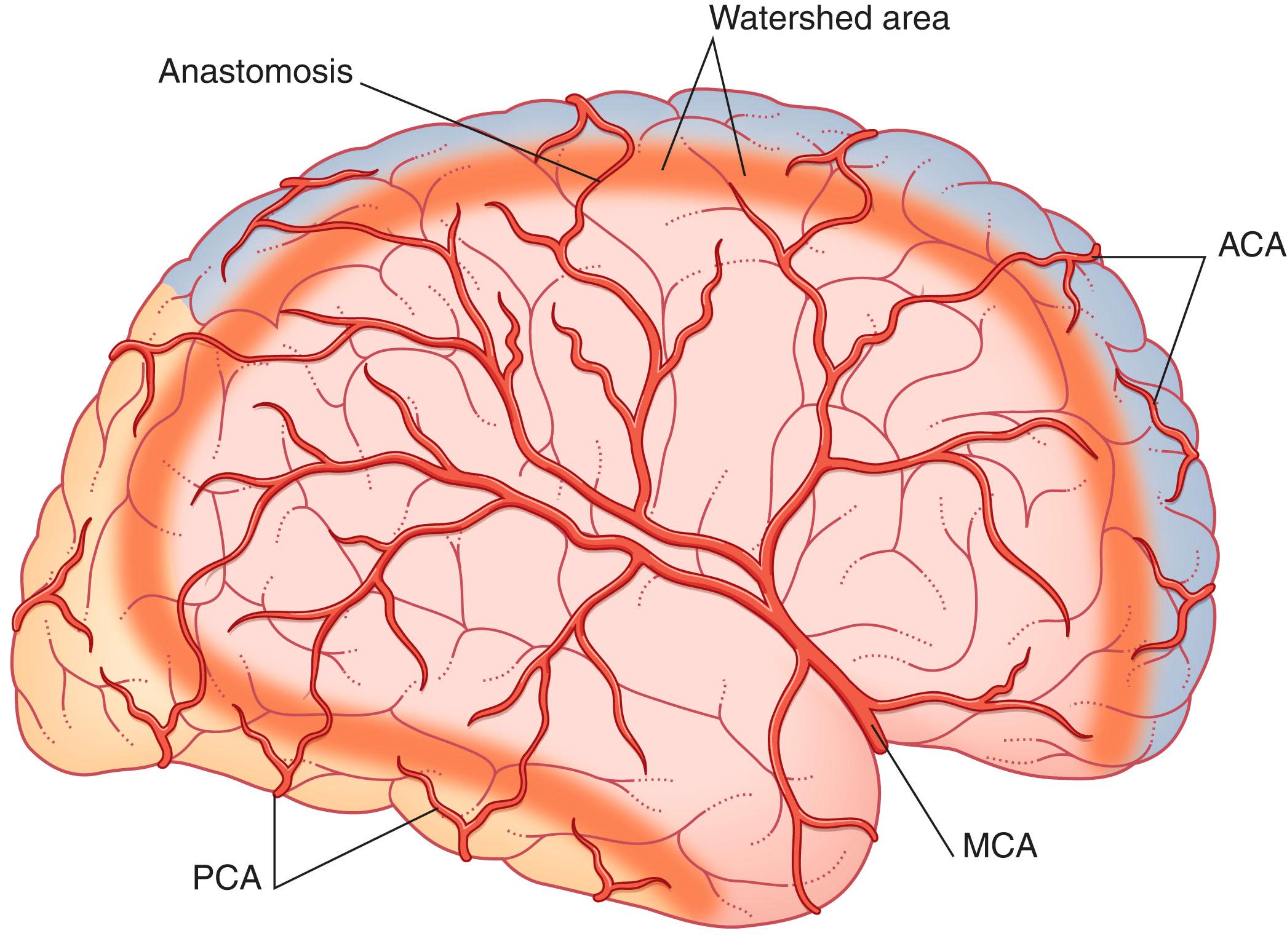
The remaining 15% of acute strokes are haemorrhagic, either intracerebral (10%) or from subarachnoid haemorrhage (5%). Most haemorrhagic strokes represent spontaneous rupture of a small cerebral vessel and hypertension is the most common aetiological factor. The remainder reflect bleeding from various vascular malformations or abnormalities of blood coagulation that predispose to bleeding.
Nontraumatic subarachnoid haemorrhage ( SAH ) is most frequently (80%) the result of rupture of an intracranial aneurysm (‘berry aneurysm’). A typical sequence of clinical events is the sudden onset of headache (‘worst headache of my life’) followed by altered mental status and signs of meningeal irritation (neck stiffness with pain on motion secondary to the irritative effects of blood). Morbidity is significant and mortality is up to 50%.
Intracranial aneurysms originate near the circle of Willis, but some arise at arterial bifurcation points within the brain. This location explains the fact that when these aneurysms rupture, blood directly enters the subarachnoid space and bleeding continues until the intracranial pressure increases and stops bleeding at the aneurysmal rupture site and thrombus forms. In up to 40% of cases there is an earlier rupture, less catastrophic, but serving as a warning or ‘ sentinel leak ’ weeks before the more serious event. This serves as the rationale for a high suspicion of SAH if an individual presents with a sudden, severe, and unusual headache.
The cranial cavity is a rigid structure and any increase in volume is associated with an increase in intracranial pressure. Cerebral infarcts (or haemorrhage) result in cytotoxic oedema that consists of an increase in intracellular water in the area of ischaemic injury. This causes an increase in intracranial pressure and displacement of cerebral structures that can result in effects at a distance by causing subfalcine or tentorial herniation of the brain in the manner of a tumour (see Chapter 5 ), and cerebral blood flow in initially unaffected vessels can also be affected. Cerebral oedema typically reaches its maximum in 72 to 120 hours and cytotoxic oedema does not respond to steroid administration (the oedema frequently encountered with brain tumours is extracellular, vasogenic oedema , and does respond to steroids).
There are other clinical conditions that can mimic a stroke as they present with neurological impairment, but symptoms are often vague and lack the localising features seen in stroke syndromes. These include seizure, brain tumour, migraine with aura, metabolic derangements that result in dysfunction of the brain, and encephalopathy (e.g. hypoglycaemia, electrolyte disturbance, drugs) as the most frequent. When history, exam, and neuroimaging are inconclusive, such individuals may initially be evaluated and treated as a stroke until time allows further clarification.
Clinicians refer to the internal carotid artery and its branches as the anterior circulation of the brain and the vertebrobasilar system (including the posterior cerebral arteries) as the posterior circulation . The anterior and posterior circulations are connected by the posterior communicating arteries ( Fig. 35.2 ). About 75% of all strokes originate in the anterior circulation.
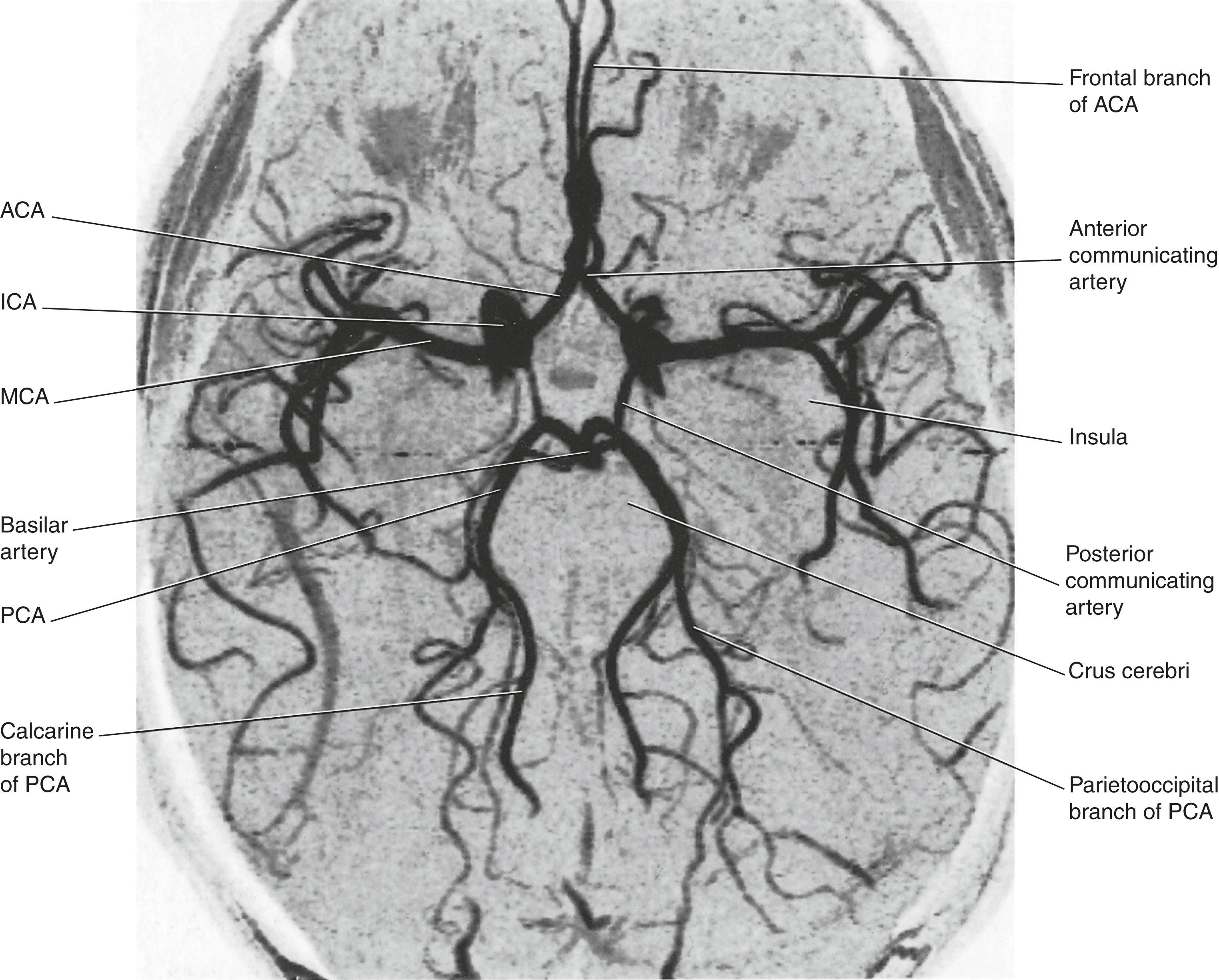
The following details supplement the account of the arterial supply of the internal capsule in Chapter 4 .
The blood supply of the internal capsule is shown in Fig. 35.3 . The three sources of supply are the anterior choroidal , a direct branch of the internal carotid; the medial striate , a branch of the anterior cerebral; and lateral striate (lenticulostriate) branches of the middle cerebral artery.
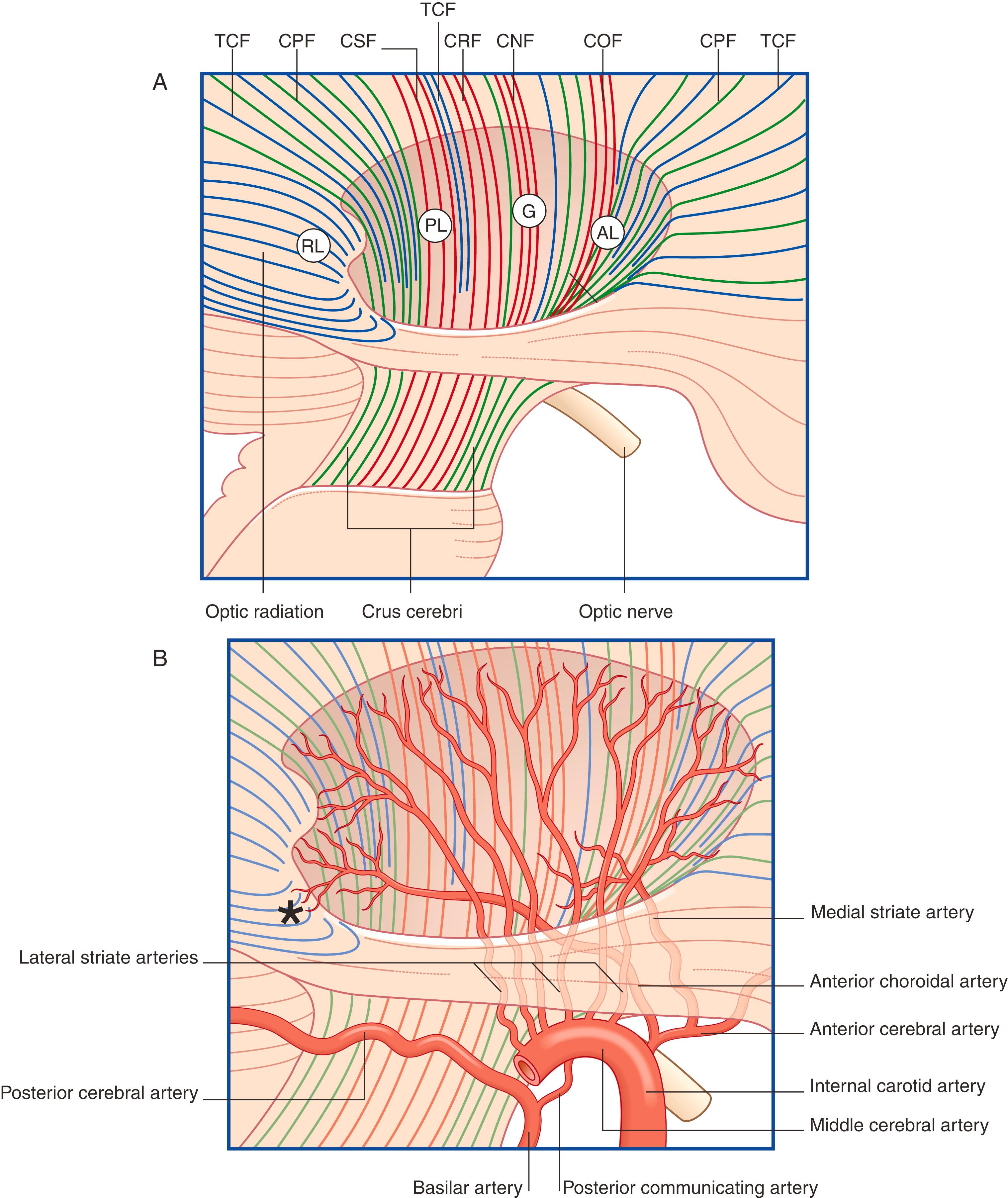
The contents of the internal capsule are shown in Fig. 35.4 . The anterior choroidal branch of the internal carotid artery supplies the lower part of the posterior limb and the retrolentiform part of the internal capsule and the inferolateral part of the lateral geniculate body. Some of its branches (not shown) supply a variable amount of the temporal lobe of the brain and the choroid plexus of the inferior horn of the lateral ventricle.
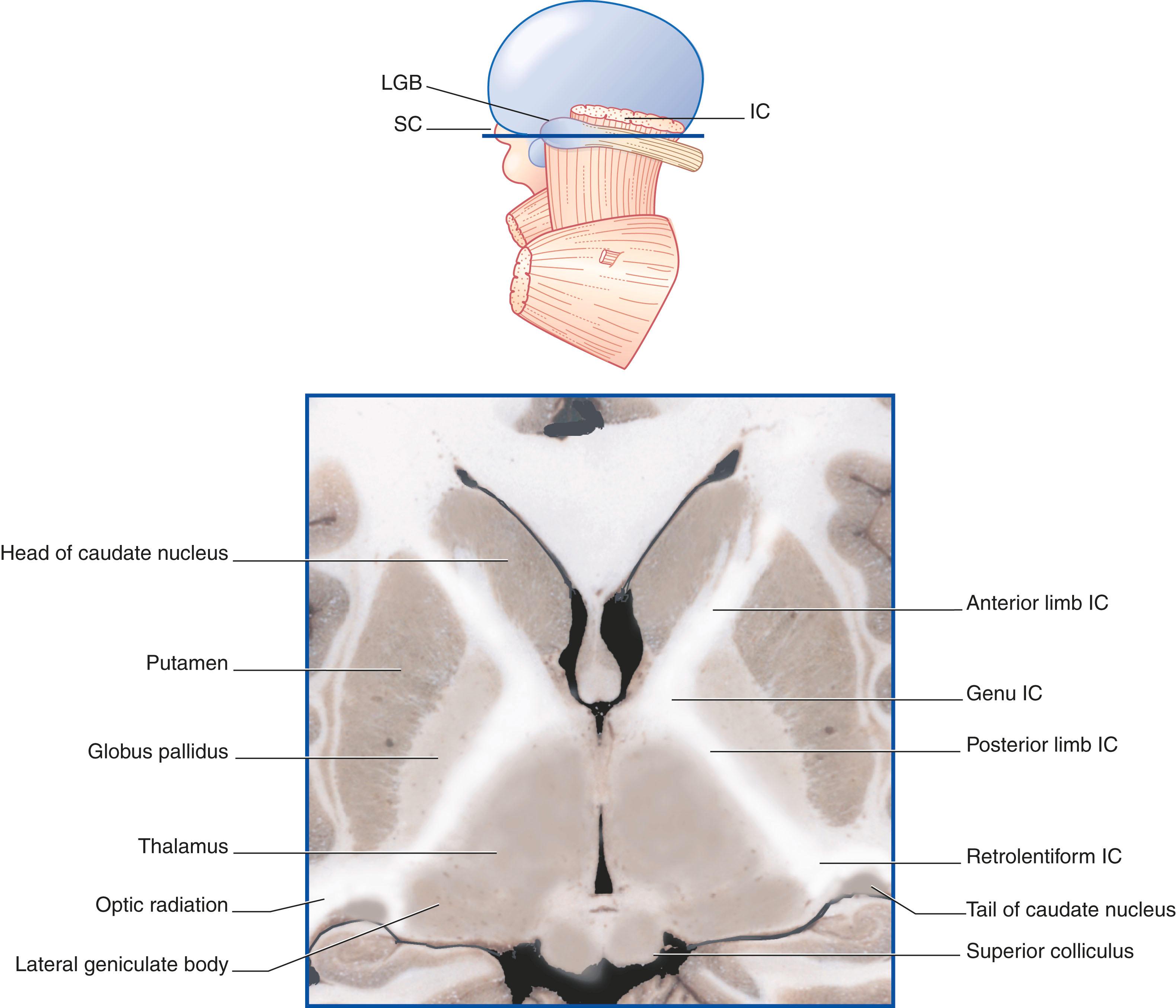
The medial striate branch of the anterior cerebral artery ( recurrent artery of Heubner ) supplies the lower part of the anterior limb of the internal capsule, genu of the internal capsule, and the head of the caudate.
The lateral striate arteries penetrate the lentiform nucleus and give multiple branches to the anterior limb, genu, and posterior limb of the internal capsule.
Additional information is confined to the stem branches of the posterior cerebral artery shown in Fig. 35.5 .
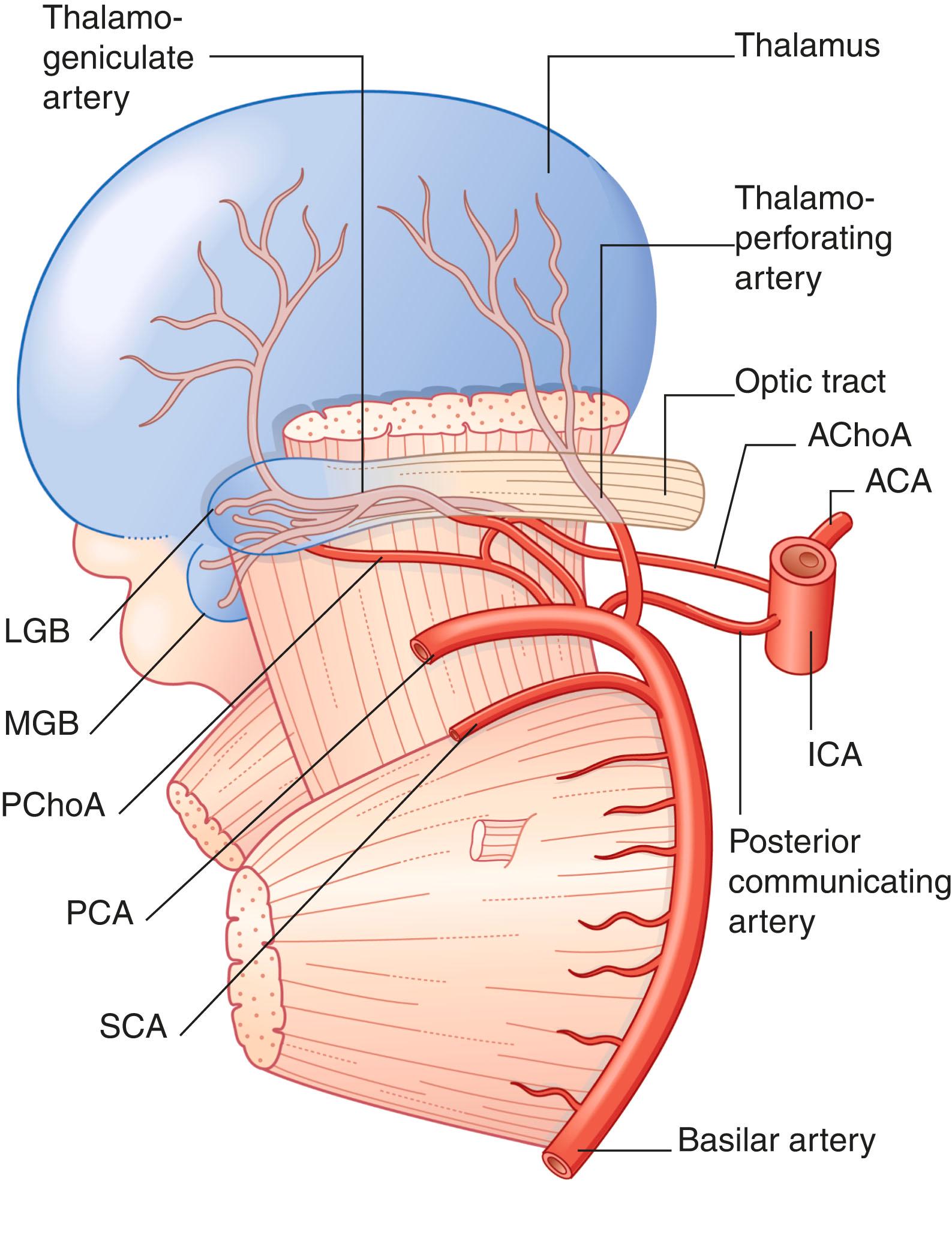
In the Clinical Panels, clinical aspects or findings with occlusion of arteries within the anterior and posterior circulation are summarised.
Contralateral hemiparesis (face = arm = leg) – lower part of the posterior limb and retrolentiform part of the internal capsule.
Contralateral hemianaesthesia – posterior ventral lateral thalamus.
Contralateral incongruent quadrantanopia or hemianopia – lateral geniculate body. Similarity between the visual field deficit in both eyes is referred to as congruency and is most marked the closer the lesion is to the visual cortex where visual pathway fibres that originate from corresponding retinal areas lie close together. The lateral geniculate receives its blood supply through the anterior (branch of the internal carotid artery) and lateral (posterior) choroidal artery (branch of the posterior cerebral artery; referred to as a ‘single artery’, it usually consists of up to 10 or 11 arteries divided into medial posterior choroidal artery and lateral posterior choroidal artery groups). Occlusion of the anterior choroidal artery can result in an incongruent upper quadrantanopia or both upper and lower quadrants can be involved, with vision spared along that horizontal meridian of the visual field supplied by the lateral choroidal artery.
Complete interruption of flow in the proximal anterior cerebral artery (ACA) is rare because the opposite artery has direct access to its distal territory through the anterior communicating artery. However, branch occlusions are well recognised, with corresponding variations in the clinical picture:
Right leg numbness (cortical sensory loss) and weakness
Transcortical motor aphasia
Ipsilateral or contralateral ideomotor apraxia
Left leg numbness (cortical sensory loss) and weakness
Motor neglect
Ipsilateral or contralateral ideomotor apraxia
The usual result is an apathetic state with some memory loss.
Dysarthria – compromise of the motor supply to the contralateral nuclei supplying the muscles of the mandible (V), lips (VII), and tongue (XII).
Hoarseness and dysphagia – when the supranuclear supply to the nucleus ambiguus is interrupted.
Become a Clinical Tree membership for Full access and enjoy Unlimited articles
If you are a member. Log in here